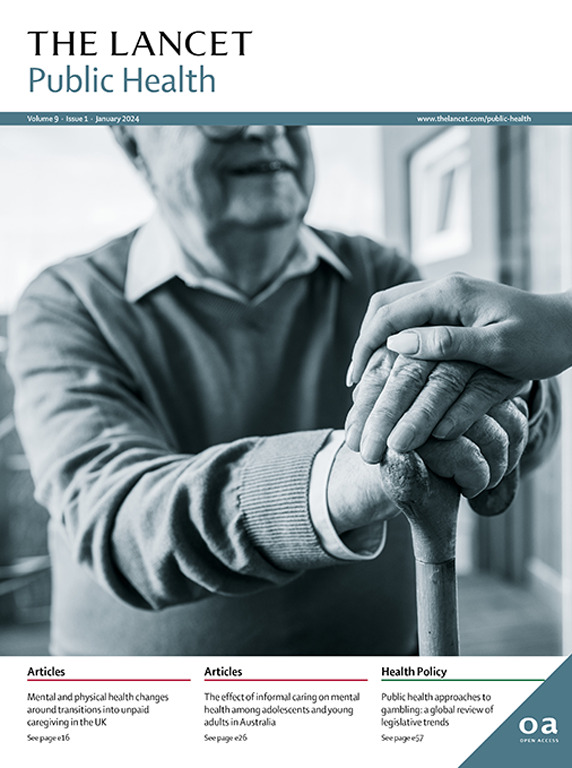残疾人和非残疾人之间的全因和特定原因死亡率不平等:澳大利亚全国数据联系研究
IF 25.4
1区 医学
Q1 PUBLIC, ENVIRONMENTAL & OCCUPATIONAL HEALTH
引用次数: 0
摘要
背景没有关于死亡率不平等的高质量统计数据,制定政策以改善残疾人的健康是具有挑战性的。我们的目标是量化澳大利亚残疾人所经历的死亡率不平等。方法在这项全国性的数据关联研究中,我们使用人口普查死亡率相关数据(2011-20)构建了一个0-74岁的澳大利亚队列。残疾被衡量为在核心日常活动中需要帮助或监督。我们估计了年龄标准化死亡率和特定年龄死亡率,以及残疾人和非残疾人之间的绝对死亡率和相对死亡率不平等。研究结果:15 216 195人参与了这项研究,其中女性7 763 047人,男性7 453 148人。在参与者中,258109名(3.5%)男性和228658名(2.9%)女性报告了残疾,在133840359人年的随访期间,有46990人死亡。每10万人年,残疾男性死亡人数比无残疾男性多2067人(95% CI 2043-2091),残疾女性死亡人数比无残疾女性多1697人(1677-1718)(分别高出3.69倍和4.64倍)。癌症和心血管疾病的绝对不平等程度最高,男性癌症发病率差异为462 (95% CI 449-476),女性癌症发病率差异为368(356-379),男性心血管疾病发病率差异为471 (95% CI 459-483),女性心血管疾病发病率差异为333(324-342)。在非残疾人中不太常见的病因——神经系统疾病、慢性肺病、内分泌疾病和消化系统疾病——在残疾人中相对常见,这导致了较高的相对死亡率不平等。最大的相对不平等来自神经系统疾病,男性的比率为9.66 (95% CI为9.31 - 10.02),女性为11.61(11.13 - 12.10)。相对和绝对的不平等在意外伤害和自杀死亡率方面也很重要。残疾人群按年龄划分的死亡率一直较高。造成绝对不平等的主要因素从年轻人的神经系统疾病转向老年人的癌症、心血管疾病和慢性肺病。残疾人经历了巨大的死亡率不平等。确定导致这些不平等的可干预因素应成为优先事项。可能有必要进行有针对性的干预和政策改革,为残疾人创造一个更具包容性的社会和保健环境。资助墨尔本大学。本文章由计算机程序翻译,如有差异,请以英文原文为准。
All-cause and cause-specific mortality inequalities between people with and without disability: a nationwide data linkage study in Australia
Background
Without high-quality statistics on mortality inequalities, designing policies to improve the health of people with disability is challenging. We aim to quantify mortality inequalities experienced by people with disability in Australia.Methods
In this nationwide, data linkage study we used Census mortality linked data (2011–20) to construct a cohort of Australians aged 0–74 years. Disability was measured as requiring assistance or supervision in core daily activities. We estimated age-standardised and age-specific mortality rates, and absolute and relative mortality inequalities between people with and without disability.Findings
15 216 195 people were included in the study, comprising 7 763 047 females and 7 453 148 males. Of the participants, 258 109 (3·5%) males and 228 658 (2·9%) females reported disability, with 462 990 deaths occurring over 138 540 359 person-years of follow-up. Per 100 000 person-years, there were 2067 (95% CI 2043–2091) more deaths in males and 1697 (1677–1718) more deaths in females with disability (3·69 and 4·64 times higher, respectively) than those without disability. Cancer and cardiovascular disease had the highest absolute inequalities, with rate differences of 462 (95% CI 449–476) for males and 368 (356–379) for females for cancer, and 471 (95% CI 459–483) for males and 333 (324–342) for females for cardiovascular disease. Less common causes among people without disability—neurological conditions, chronic lung diseases, endocrine diseases, and digestive diseases—are relatively common among people with disability, translating to high relative mortality inequalities. The largest relative inequalities were from neurological conditions, with rate ratios of 9·66 (95% CI 9·31–10·02) for males and 11·61 (11·13–12·10) for females. Relative and absolute inequalities were also substantial for unintentional injury and for suicide mortality. Age-specific mortality was consistently higher in people with disability. The leading contributors to absolute inequalities shifted from neurological conditions in younger ages to cancer, cardiovascular diseases, and chronic lung diseases in older ages.Interpretation
People with disability experience large mortality inequalities. Identifying intervention-amenable factors contributing to these inequalities should be a priority. Targeted interventions and policy reforms to create a more inclusive social and health-care environment for people with disability might be necessary.Funding
The University of Melbourne.求助全文
通过发布文献求助,成功后即可免费获取论文全文。
去求助
来源期刊

Lancet Public Health
Medicine-Public Health, Environmental and Occupational Health
CiteScore
55.60
自引率
0.80%
发文量
305
审稿时长
8 weeks
期刊介绍:
The Lancet Public Health is committed to tackling the most pressing issues across all aspects of public health. We have a strong commitment to using science to improve health equity and social justice. In line with the values and vision of The Lancet, we take a broad and inclusive approach to public health and are interested in interdisciplinary research.
We publish a range of content types that can advance public health policies and outcomes. These include Articles, Review, Comment, and Correspondence. Learn more about the types of papers we publish.
 求助内容:
求助内容: 应助结果提醒方式:
应助结果提醒方式:


